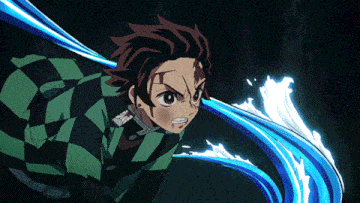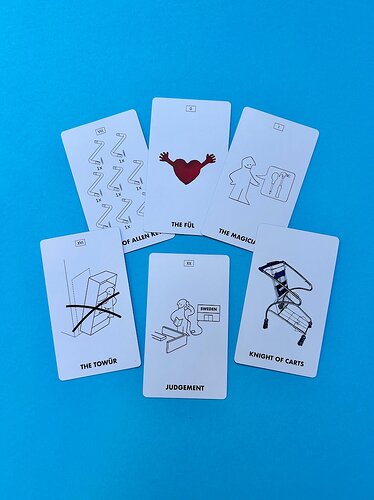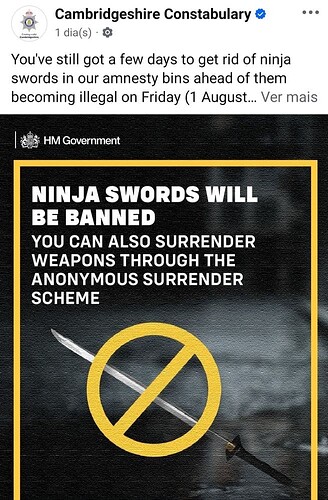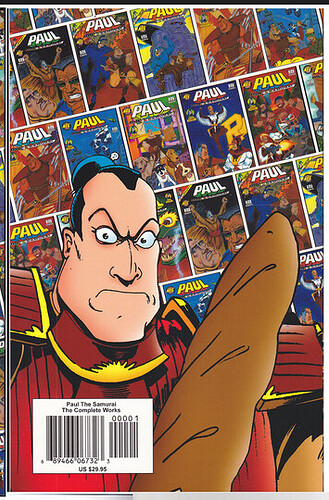This… is going to be a favorite case study for preventing trafficking training…
Whew! Thank god I don’t have Ninja Swords. Now, if they banned katana, wakizashi, tanto, tachi, or odachi I’d be right mad!
What a dumb ban, i looked it up to see if i could find more info
It doesn’t really seem to meaningfully define what a “ninja sword” is, but it does seem that the intent at least is to regulate and restrict the sale of knives to people who are underage.
I’m now picturing British sword-bros arguing about what makes a “ninja sword,” same as American gun-bros do with “assault rifles.” And of course, they only use their ninja swords for dealing with 40-50 feral hogs.
I did find another source that did give more specifics (aka a forum post)
You’re probably wondering what a “ninja sword” even is. According to the British Home Office, the machete-like device is “a fixed bladed article with a blade between 14-24 inches” with “a single straight cutting edge,” “a tanto style point,” or “a reversed tanto style point.” The government also concedes that “there is not a precise historical description of what a ninja sword is,” which could lead to this ban being equally as subjective as U.S.-proposed “red flag” laws.
Hold on… enhance…
The government also concedes that “there is not a precise historical description of what a ninja sword is,”

Didn’t this happen in 80s? Teenage Mutant Hero Turtles and all that…
I think it is related to Kimetsu No Yaiba.

So it’s just long swords & sabers now?
Don’t forget zweihanders
The panic back then over “ninja” violence was focussed on Nunchaku and throwing stars. I can only assume that this was caused by samurai influence within the UK government.
“Bro, that sword isn’t a so-called “ninja” sword. That sword can only cut through 2 bodies. A real ninja sword could easily do 5 bodies. All your arguments are therefore invalid. QED.”
Soooo…you called the protective storage receptacle a “sheath” when it’s clearly a “scabbard,” which tells me you don’t know enough to even have an opinion about whether it should be legal or not!
Are the swords the “moors” used considered sabers?
Swords are not something I’m super knowledgeable about.
I’ll have to start baking my ninja sword into a baguette like Paul the Samurai.

But of course, while searching for a PTS image, I discover someone did this in real life already. ![]()
Sigh, swords are complicated. Something something category debates.
In the broadest understanding, katanas could be categorized as sabers, which are (again, in the broadest understanding) any curved, single-edged weapon optimized for cutting over thrusting. There are certainly narrower conceptions of what constitutes a saber – Wikipedia gives the (over-narrow, in my opinion) definition:
a type of backsword with a curved blade associated with the light cavalry of the early modern and Napoleonic periods.
Of course, you can find military sabers that have straight edges. And many, many sabers, though they have a primary “true” edge, also have some portion of their false edge sharpened.
Certainly I would say that many swordists would take a relatively broad view of what constitutes a saber and consider things like the shamshir and the dao to be sabers – but would probably exclude backswords with straight edges (and refer to such as “backswords” or some other classification depending on their construction). That said, there are sword nerds who get absolutely up in arms about which words get applied to which weapons (ask me some time about “claymore”).
Katanas are often treated conceptually as kind of their own thing, since they have such a deep (and relatively insular) history, so it’s not without good reason that someone might exclude them from even a reasonably broad definition of “saber”.
(Even the word “katana” is complicated, since in English it sometimes specifically refers to the evolution of the Japanese longsword intended to be worn edge-up (in contrast to the edge-down tachi), and sometimes refers to the single-edged Japanese sword broadly (which some folks would insist are correctly referred to categorically as nihonto, though even this is additionally complicated since nihonto could properly include double-edge swords like tsurugi).
(Another fun and interesting fact: there is no known historical precedent for a (specifically) “ninja sword”. This sometimes gets referred to as a ninjato and generally is as described in the article: a wakizashi-length sword with a single edge, tanto point, and straight blade. But the evidence seems to suggest that this is a 20th century invention with no known historical counterpart.)





